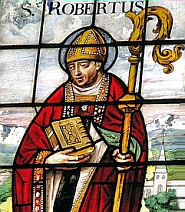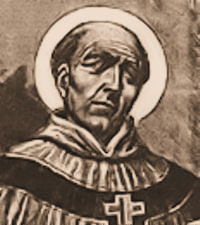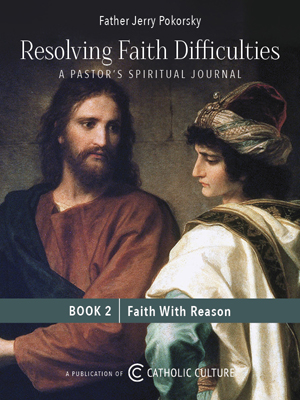Easter: June 7th
Saturday of the Seventh Week of Easter (Vigil of Pentecost)
Other Commemorations: St. Robert of Newminster, Priest (RM)
» Enjoy our Liturgical Seasons series of e-books!
The Roman Martyrology commemorates St. Robert of Newminster (1100-1159). He was born at Gargrave in Yorkshire. He spent the early years of his priesthood as rector of his hometown but later joined the Benedictine community at Whitby. In 1132 he helped to establish Fountains Abbey which embraced the Cistercian rule of St. Bernard of Clairvaux. Fountains was to have a daughter abbey at Newminster near Morpeth and Robert became the first abbot in 1138/9. He died on June 7, 1159.
Tomorrow is the Solemnity of Pentecost, the end of the Easter season. Observance of the solemnity begins with First Vespers (Evening Prayer I) in the Liturgy of the Hours, and a special Vigil Mass before or after First Vespers. The liturgical day is from midnight to midnight in the Church's observance, except for Sunday and solemnities which begin with the evening of the preceding day.
The Pentecost Vigil liturgy has an Extended Form which echoes the Easter Vigil. There are four readings and Responsorial Psalms and prayers:
- 1st: Genesis 11:1-9 and Psalm 33(32): It was called Babel because there the Lord confused the speech of all the world.
- 2nd: Exodus 19:3-8a, 16-20b and Canticle of Daniel or Psalm 19 (18): The Lord came down upon Mount Sinai before all the people.
- 3rd: Ezekiel 37:1-14 and Psalm 107 (106): Dry bones of Israel, I will bring spirit into you, that you may come to life.
- 4th: Joel 3:1-5 and Psalm 104 (103): I will pour out my spirit upon the servants and handmaids.
>>>Today concludes the Pentecost Novena to the Holy Spirit.<<<
Meditation for Saturday of the Seventh Week of Easter:
Preparation for Pentecost: Prayer to the Father and the Son from Whom the Holy Ghost proceeds
Let us ask the Holy Ghost to enter into us and increase in us the abundance of His gifts. Fervent prayer is the condition of His indwelling in our souls. Humility is another condition. Let us come before Him with the intimate conviction of our inward poverty.
Despite our miseries, let us invoke Him; on account of these very miseries, He will hear us. Veni, Pater pauperum.
And since He is one with the Father and the Son, let us say likewise to the Father: Father, send down upon us, in the name of Thy Son Jesus, the Spirit of love that He may fill us with the intimate sense of our divine filiation. And Thou, O Jesus, our High Priest, now sitting at Thy Father's right hand, intercede for us, so that this mission of the Spirit, Whom Thou didst promise to us and didst merit for us, may be abundant; that it may be an impetuous river making glad the city of souls; or rather, according to Thine own words, "a fountain of water, springing up unto life." Hoc autem dicebat de Spiritu Sancto quem accepturi erant credentes in eum.
—Dom Columba Marmion, Christ in His Mysteries, p. 340

Pentecost Vigil,
Station with San Giovanni in Laterano (St. John Lateran)
The Station is at St. John Lateran, beside the Baptistery. The night before Pentecost, like that before Easter, was at Rome, and in many other churches, a baptismal feast. Baptism was administered to those who, for one reason or another, had not received it at Easter; or to fresh candidates. Hence the resemblance between these two Virgils. It also expresses the idea of our Baptism by the Holy Spirit.
For more on San Giovanni in Laterano, see:
- Churches of Rome
- Rome Art Lover
- Roman Churches
- Aleteia
- Click here for a 360 degree virtual tour.
For further information on the Station Churches, see The Stational Church.
St. Robert of Newminster
 St. Robert was born at Gargrave, England, at the beginning of the 12th century. He studied at the University of Paris, was ordained priest and served as a parish priest at Gargrave. In 1132 Robert was a monk at Whitby England. News arrived that thirteen religious had been violently expelled from the Abbey of Saint Mary in York, for having proposed to restore the Benedictine/Cistercian rule. In the middle of winter, he left Whitmy to join them, living on the banks of the Skeld near Ripon., in a hut made of woven branches and roofed with turf. In the spring they went to Clairvaux, and for two years struggled in extreme poverty.
St. Robert was born at Gargrave, England, at the beginning of the 12th century. He studied at the University of Paris, was ordained priest and served as a parish priest at Gargrave. In 1132 Robert was a monk at Whitby England. News arrived that thirteen religious had been violently expelled from the Abbey of Saint Mary in York, for having proposed to restore the Benedictine/Cistercian rule. In the middle of winter, he left Whitmy to join them, living on the banks of the Skeld near Ripon., in a hut made of woven branches and roofed with turf. In the spring they went to Clairvaux, and for two years struggled in extreme poverty.
Soon people heard of their sanctity. This brought another novice, Hugh, Dean of York, who endowed the community with all his wealth, and laid the foundation of Fountains Abbey. In 1137 Raynulph, Baron of Morpeth, was so taken and strengthened by the example of the monks at Fountains that he built them a monastery in Northumberland, called Newminster, of which Saint Robert became Abbot. The holiness of his life and his instructions guided his brethren to perfection, and within the next ten years three new communities migrated from this one house to become centers of holiness in other parts. He founded three other monasteries at Pipewell in 1143, Roche in 1147, and Sawley in 1148.
St. Robert was known for his kindness, austerity and holiness. He was a great man of prayer, a spiritual writer and exorcist. He led a strict way of life and fasted from food and drink, especially during Lent. One Easter Day his stomach, weakened by the fast of Lent, could take no food. Finally he consented to try to eat some bread sweetened with honey. Before it was brought, he changed his mind and sent the food, untouched, to the poor at the gate. The plate was received by a young man who took the bread and disappeared. St. Robert often visited a holy hermit, Saint Godric of Finchale. At the moment of Saint Robert’s death in 1159, Saint Godric saw his soul, like a globe of fire, taken up by the Angels in a pathway of light, while the gates of heaven opened before them. He took his name from Newminster Abbey, where he and his monks lived until his death on June 7, 1159.
—Mark Konewko, St. Robert Parish
Symbols and Representation: St. Robert is usually depicted as an abbot holding a church, representing his work founding Cistercian abbeys.
Highlights and Things to Do:
- Newminster Abbey was dissolved, and the abbey is now a ruin, used a source of stone for building. These sites have some current photos of the ruins: The Cistercians in Yorkshire and Keys to the Past Archive.
- Find out more about St. Robert:






